Evaluation of the Slip Sinkage and its Effect on the Compaction Resistance of an Off-Road Tracked Vehicle
Abstract
1. Introduction
2. Ground Sinkage and Motion Resistance of Off-Road Tracked Vehicles
3. Experiment Program
3.1. Experiment Equipment
3.2. Model Ground
3.3. Experiment Procedure and Conditions
- (1)
- A surcharge mass simulating the weight of the off-road tracked vehicle was installed on the model track system, and the vertical displacement generated in the model track system was measured to determine the static sinkage.
- (2)
- Longitudinal load (3% strain/min) simulating the driving torque of an off-road tracked vehicle was applied to the model track system, while vertical and longitudinal displacement were measured using the LVDT to determine slip sinkage and slip displacement, respectively. Vertical displacement (i.e., slip sinkage) was measured at the center point of the surcharge mass during the experiments.
4. Experiment Results and Discussion
4.1. Failure Surface
4.2. Observation of the Failure Surface
4.3. Evaluation of the Normalized Slip Sinkage
5. Empirical Equation for Slip Sinkage of a Track System
6. Evaluation of Compaction Resistance Considering Slip Sinkage
7. Conclusions
- (1)
- In the model track experiments, the soil block was formed and failure occurred along the bottom and side ground of the block regardless of the ground density and vertical stress conditions. That is, slip sinkage of the off-road tracked vehicle was induced by vertical displacement caused by shearing action in the soil block formed on the soil–track interface. This is similar to the phenomenon in which vertical displacement of the sample occurs in the soil direct shear test. However, as the soil block is rigidly constrained on only the side with grousers, it did not show the exact same tendencies.
- (2)
- Downward slip sinkage occurred in the soil–track interface under all experimental conditions. The extent of slip sinkage gradually increased with slip displacement, though the rate of increase gradually decreased. In addition, slip sinkage increased as surcharge mass increased and relative density of the soil decreased. We expect that it will be difficult to ensure tractive performance for heavy-weight off-road tracked vehicles driving on loose ground.
- (3)
- Normalized slip sinkage, defined as the ratio of slip sinkage to static sinkage, which is caused by vehicle weight, increases with slip displacement. However, it is not greatly affected by surcharge mass or relative density of the soil. From the experiment results, we proposed an equation for assessing the slip sinkage of off-road tracked vehicles. We used the proposed equation to predict the results of the additional model experiments for verification and confirmed that the slip sinkage of off-road tracked vehicles can be predicted relatively accurately using the proposed formula.
- (4)
- We proposed a method for assessing the compaction resistance of off-road tracked vehicles considering the effect of slip sinkage using the proposed slip sinkage equation. A parametric study was conducted taking into account the driving conditions of the off-road tracked vehicle. Overall compaction resistance was estimated to be about 7.35–54.01 times higher than when static sinkage alone was considered. These results indicate that the effect of slip sinkage should be considered when assessing the tractive performance of off-road tracked vehicles, and that tractive performance can be overestimated when compaction resistance is calculated considering only static sinkage.
Author Contributions
Funding
Acknowledgments
Conflicts of Interest
References
- Yong, R.N.; Fattah, E.A.; Skiadas, N. Vehicle Traction Mechanics; Elsevier: Amsterdam, The Netherlands, 1984. [Google Scholar]
- Wong, J.Y. Terramechanics and Off-Road Vehicle Engineering; Elsevier: Amsterdam, The Netherlands, 1989. [Google Scholar]
- Bekker, M.G. Off-the-Road Locomotion; University of Michigan Press: Ann Arbor, MI, USA, 1960. [Google Scholar]
- Bekker, M.G. Theory of Land Locomotion; University of Michigan Press: Ann Arbor, MI, USA, 1956. [Google Scholar]
- Kogure, K.; Ohira, Y.; Tamaguchi, H. Prediction of sinkage and motion resistance of a tracked vehicle using plate penetration test. J. Terramech. 1983, 20, 121–128. [Google Scholar] [CrossRef]
- Kacigin, V.V.; Guskov, V.V. The basis of tractor performance theory. J. Terramech. 1968, 5, 43–66. [Google Scholar] [CrossRef]
- Kogure, K. External motion resistance caused by rut sinkage of a tracked vehicle. J. Terramech. 1976, 13, 1–14. [Google Scholar] [CrossRef]
- Wong, J.Y.; Huang, W. “Wheels vs. tracks”—A fundamental evaluation from the traction perspective. J. Terramech. 2006, 43, 27–42. [Google Scholar] [CrossRef]
- Baek, S.H.; Shin, G.B.; Kwon, O.S.; Chung, C.K. Evaluation of tractive performance of an underwater tracked vehicle based on soil-track interaction theory. J. Korean Geotech. Soc. 2018, 34, 43–54. [Google Scholar]
- Janosi, Z.; Hanamoto, B. An Analysis of the Drawbar Pull vs Slip Relationship for Track Laying Vehicles; Army Tank-Automotive Center: Warren, MI, USA, 1961. [Google Scholar]
- Weiss, S.J. Preliminary Study of Snow Values Related to Vehicle Performance; Land Locomotion Research Laboratory: Detroit, MI, USA, 1956. [Google Scholar]
- Ksenevich, I.P.; Skotnikov, V.A.; Lyasko, M.I. Undercarriage Systems, Soil, Crop; Agropromizdat: Moscow, Russia, 1985. [Google Scholar]
- Lyasko, M. Slip sinkage effect in soil-vehicle mechanics. J. Terramech. 2010, 47, 21–31. [Google Scholar] [CrossRef]
- Reece, A.R. Principles of soil-vehicle mechanics. Proc. Inst. Mech. Eng. Automob. Div. 1965, 180, 45–66. [Google Scholar] [CrossRef]
- Vasil’ev, A.V.; Dokychaeva, E.N.; Utkin-Lubovtsov, O.L. Effect of Tracked Tractor Design Parameters on Tractive Performance; Mashinostroenie: Moscow, Russia, 1969. [Google Scholar]
- Reece, A.R. The effect of grousers on off-the-road vehicle performance. J. Agric. Eng. Res. 1964, 9, 360–371. [Google Scholar]
- WES. Working Draft, Part Two, Road Chapter 9, Soils Trafficability; USA Army Corps of Engineers Waterways Experiment Station: Vicksburg, MS, USA, 1994. [Google Scholar]
- Grečenko, A. Re-examined principles of thrust generation by a track on soft ground. J. Terramech. 2007, 44, 123–131. [Google Scholar] [CrossRef]
- Baek, S.H.; Shin, G.B.; Chung, C.K. Assessment of the side thrust for off-road tracked vehicles based on the punching shear theory. J. Terramech. 2018, 79, 59–68. [Google Scholar] [CrossRef]
- Iai, S. Similitude for shaking table tests on soil-structure-fluid model in 1g gravitational field. Soils Found. 1989, 29, 105–118. [Google Scholar] [CrossRef]
- Hwang, J.I. Behavior of Piles Subjected to Flow of Liquefied Soil and Verification of Similitude Law for 1g Shaking Table Tests; Seoul National University: Seoul, Korea, 2004. [Google Scholar]
- Ozkahriman, F.; Wartman, J. Investigation of 1-g similitude laws by “modeling of models” exercise. Adv. Meas. Model. Soil Behavior. 2007. [Google Scholar] [CrossRef]
- Yang, E.K. Evaluation of Dynamic P-Y Curves for a Pile in Sand from 1g Shaking Table Tests; Seoul National University: Seoul, Korea, 2009. [Google Scholar]
- Baek, S.H.; Kim, J. Applicability of the 1g similitude law to the physical modeling of soil-track interaction. J. Terramech. 2019, 85, 27–37. [Google Scholar] [CrossRef]
- Gibson, A.D. Physical Scale Modeling of Geotechnical Structures at One-G; California Institute of Technology: Pasadena, CA, USA, 1997. [Google Scholar]
- Park, Y.H. Interaction of Soils-Tracked Vehicle; Seoul National University: Seoul, Korea, 1996. [Google Scholar]
- Lee, I.M.; Sung, S.G.; Cho, G.C. Effect of stress state on the unsaturated shear strength of a weathered granite. Can. Geotech. J. 2005, 42, 624–631. [Google Scholar] [CrossRef]
- Frost, J.D.; Park, J.Y. A critical assessment of the moist tamping technique. Geotech. Test. J. 2003, 26, 57–70. [Google Scholar]
- Das, B.M. Principles of Foundation Engineering; PWS-KENT Publishing Company: Boston, MA, USA, 1983. [Google Scholar]
- Savitzky, A.; Golay, M.J.E. Smoothing and differentiation of data by simplified least squares procedures. Anal. Chem. 1964, 36, 1627–1639. [Google Scholar] [CrossRef]
- Lambe, T.W.; Whitman, R.V. Soil Mechanics; John Wiley & Sons: Hoboken, NJ, USA, 1979. [Google Scholar]
- Dwyer, M.J.; Comely, D.R.; Evernden, D.W. The field performance of some tractor tyres related to soil mechanical properties. J. Agric. Eng. Res. 1974, 19, 35–50. [Google Scholar] [CrossRef]
- Okello, A. A review of soil strength measurement techniques for prediction of terrain vehicle performance. J. Agric. Eng. Res. 1991, 50, 129–155. [Google Scholar] [CrossRef]
- McKyes, E.; Fan, T. Multiplate penetration tests to determine soil stiffness moduli. J. Terramech. 1985, 22, 157–162. [Google Scholar] [CrossRef][Green Version]
- Galati, R.; Reina, G. Terrain awareness using a tracked skid-steering vehicle with passive independent suspensions. Front. Robot. AI 2019, 6, 46. [Google Scholar] [CrossRef]
- Martini, A.; Bellani, G.; Fragassa, C. Numerical assessment of a new hydro-pneumatic suspension system for motorcycles. Int. J. Automot. Mech. Eng. 2018, 15, 5308–5325. [Google Scholar] [CrossRef]
- Palomares, E.; Morales, A.L.; Nieto, A.J.; Chicharro, J.M.; Pintado, P.; Gómez-Garciá, M.J. Modelling magnetorheological dampers in preyield and postyield regions. Shock Vib. 2019. [Google Scholar] [CrossRef]
- Odabaşi, V.; Maglio, S.; Martini, A.; Sorrentino, S. Static stress analysis of suspension systems for a solar-powered car. FME Trans. 2019, 47, 70–75. [Google Scholar] [CrossRef]
- Baek, S.; Shin, G.; Chung, C. Experimental study on the soil thrust of underwater tracked vehicles moving on the clay seafloor. Appl. Ocean Res. 2019, 86, 117–127. [Google Scholar] [CrossRef]
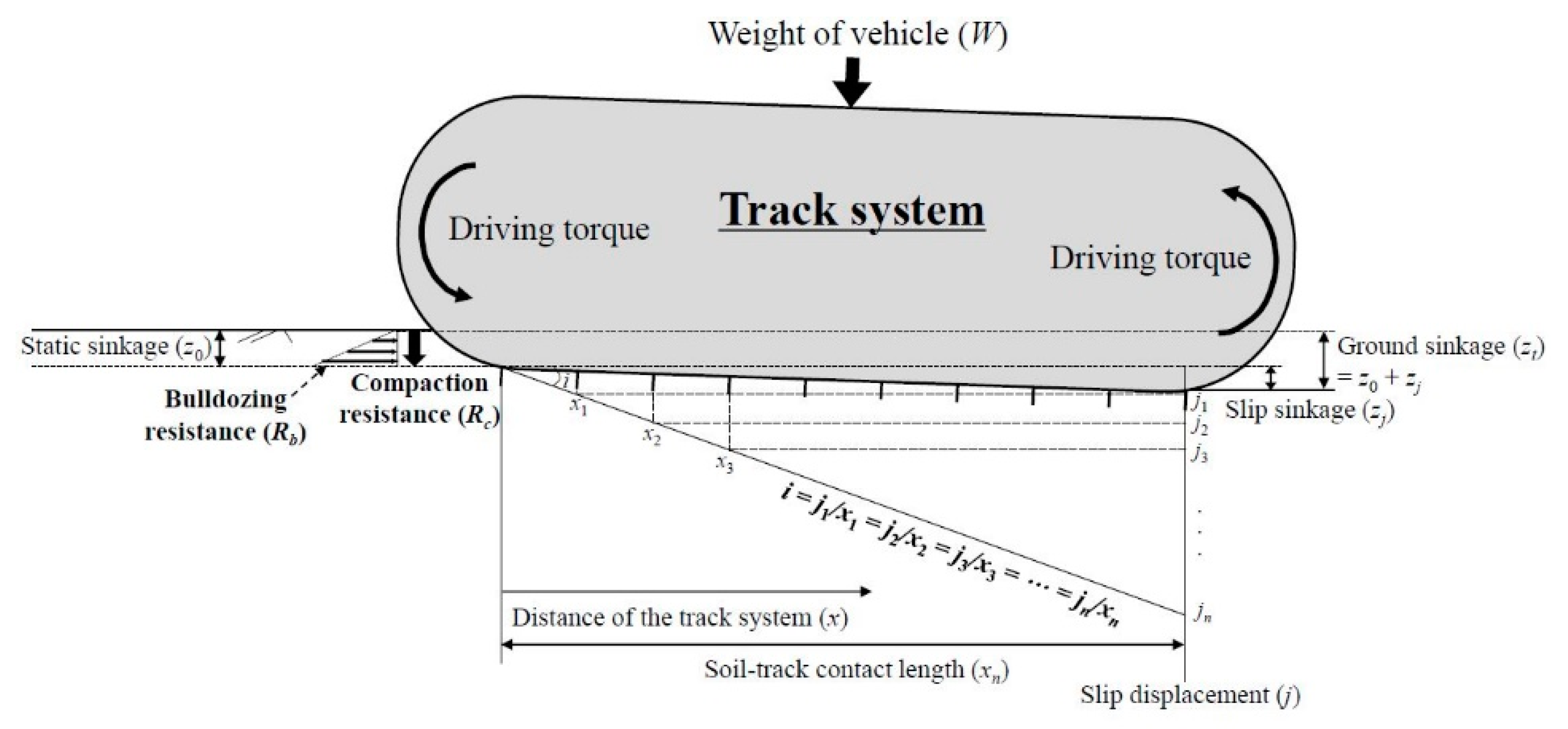
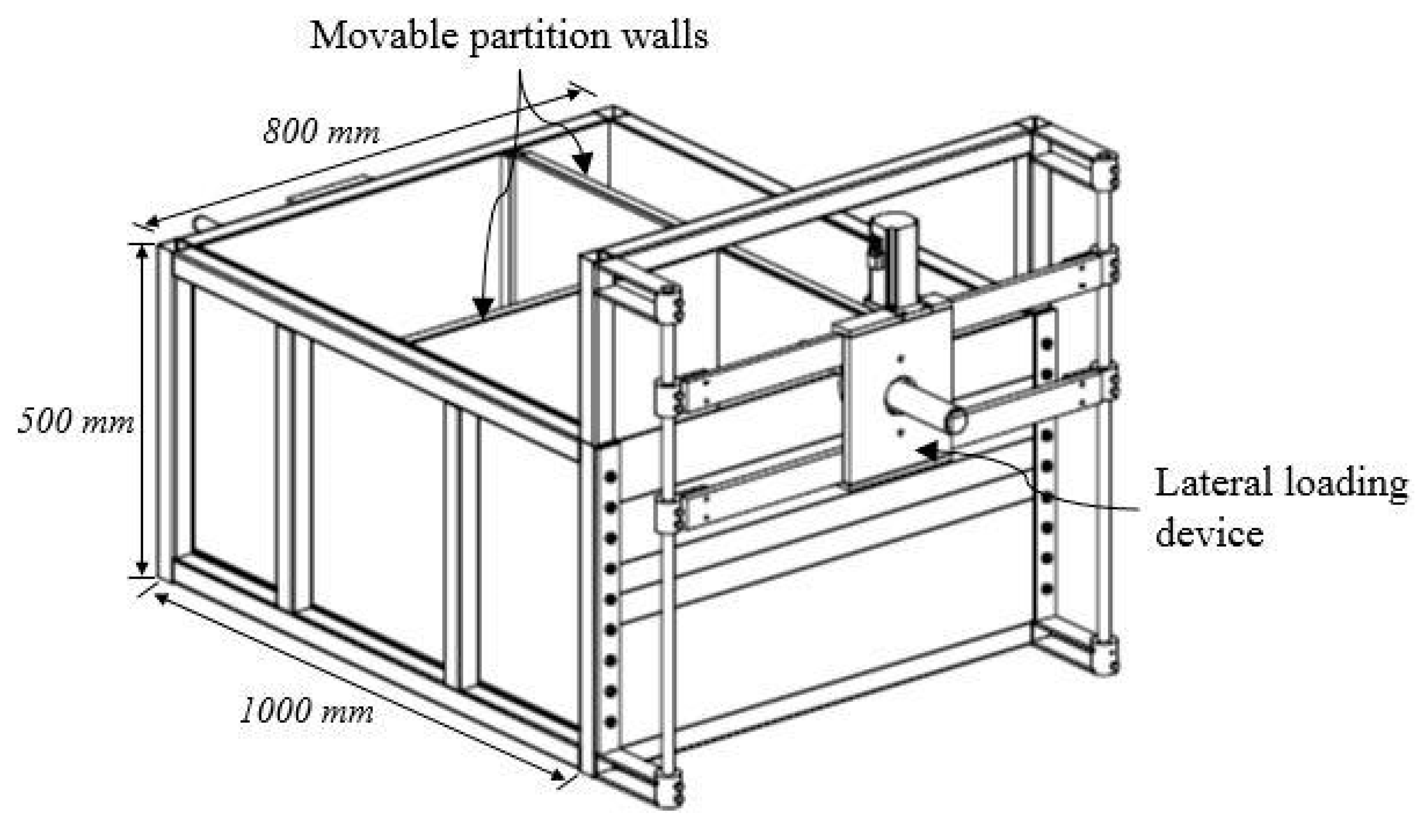

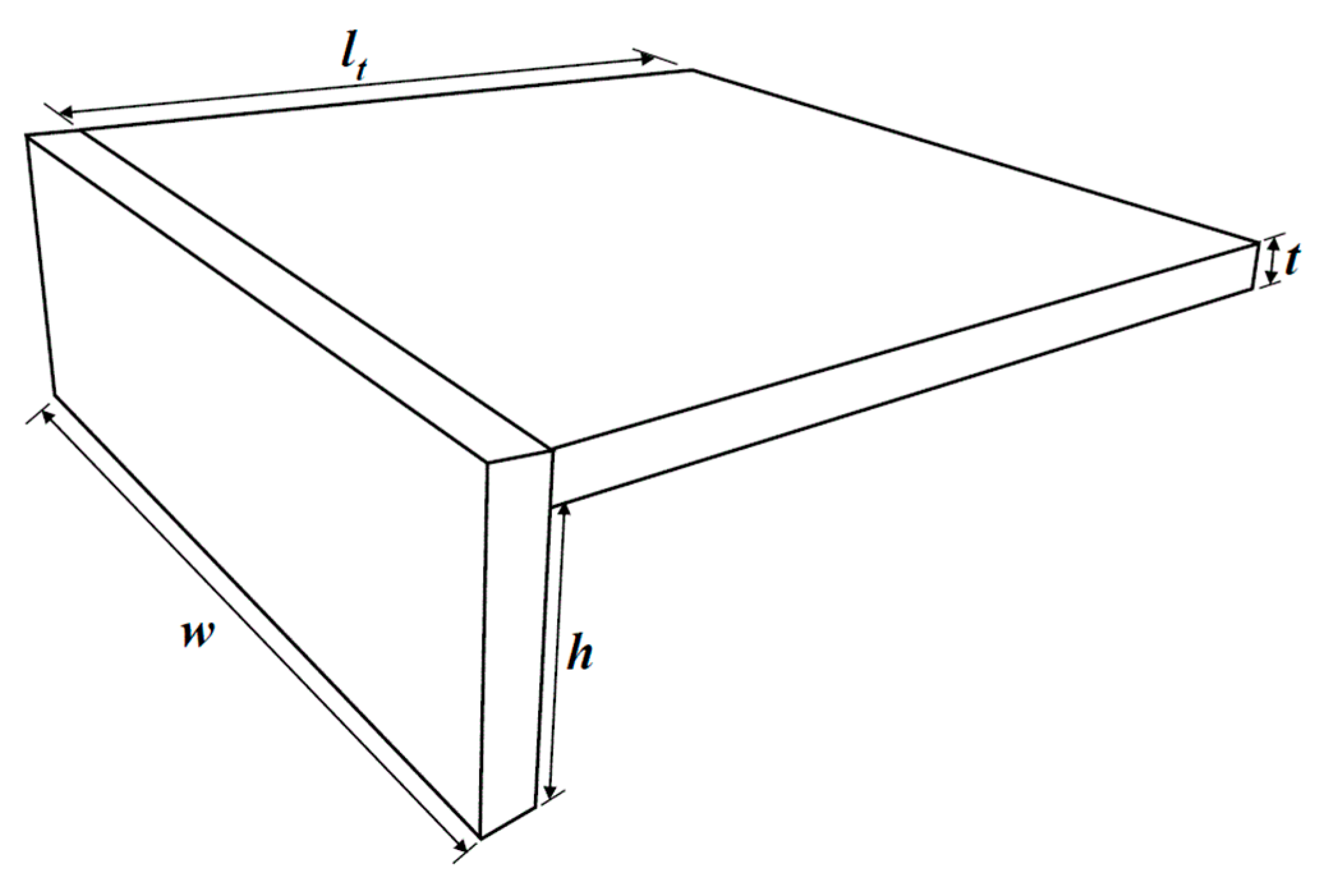
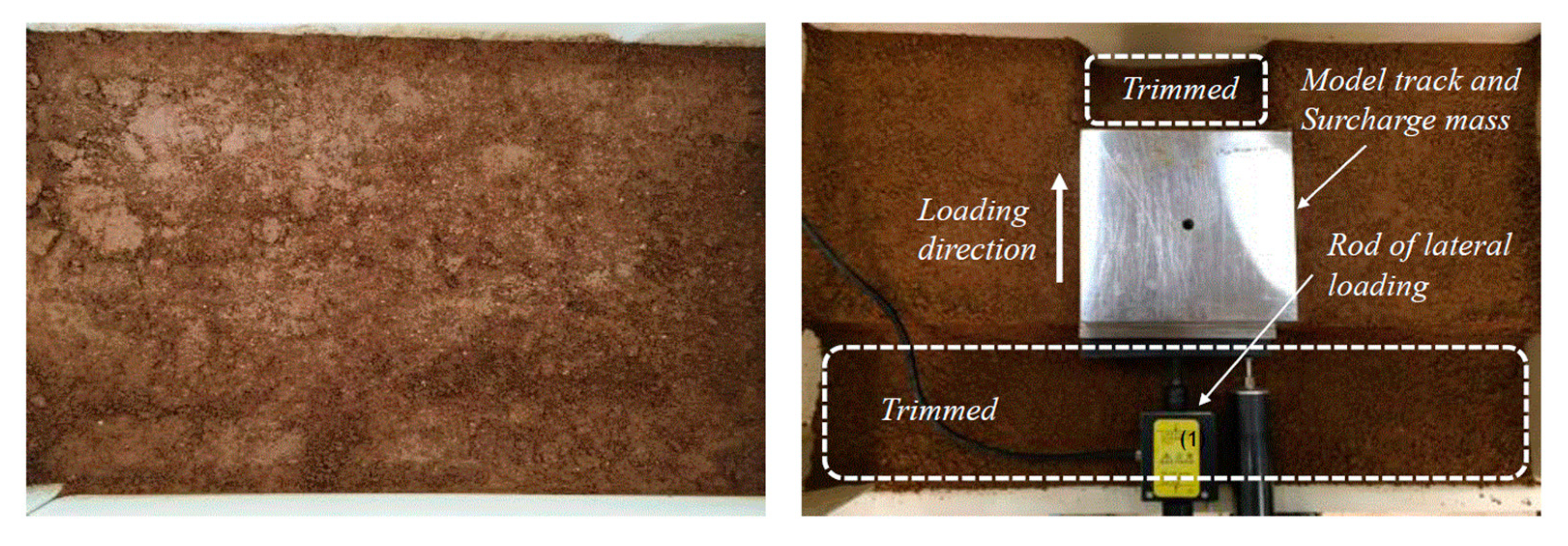
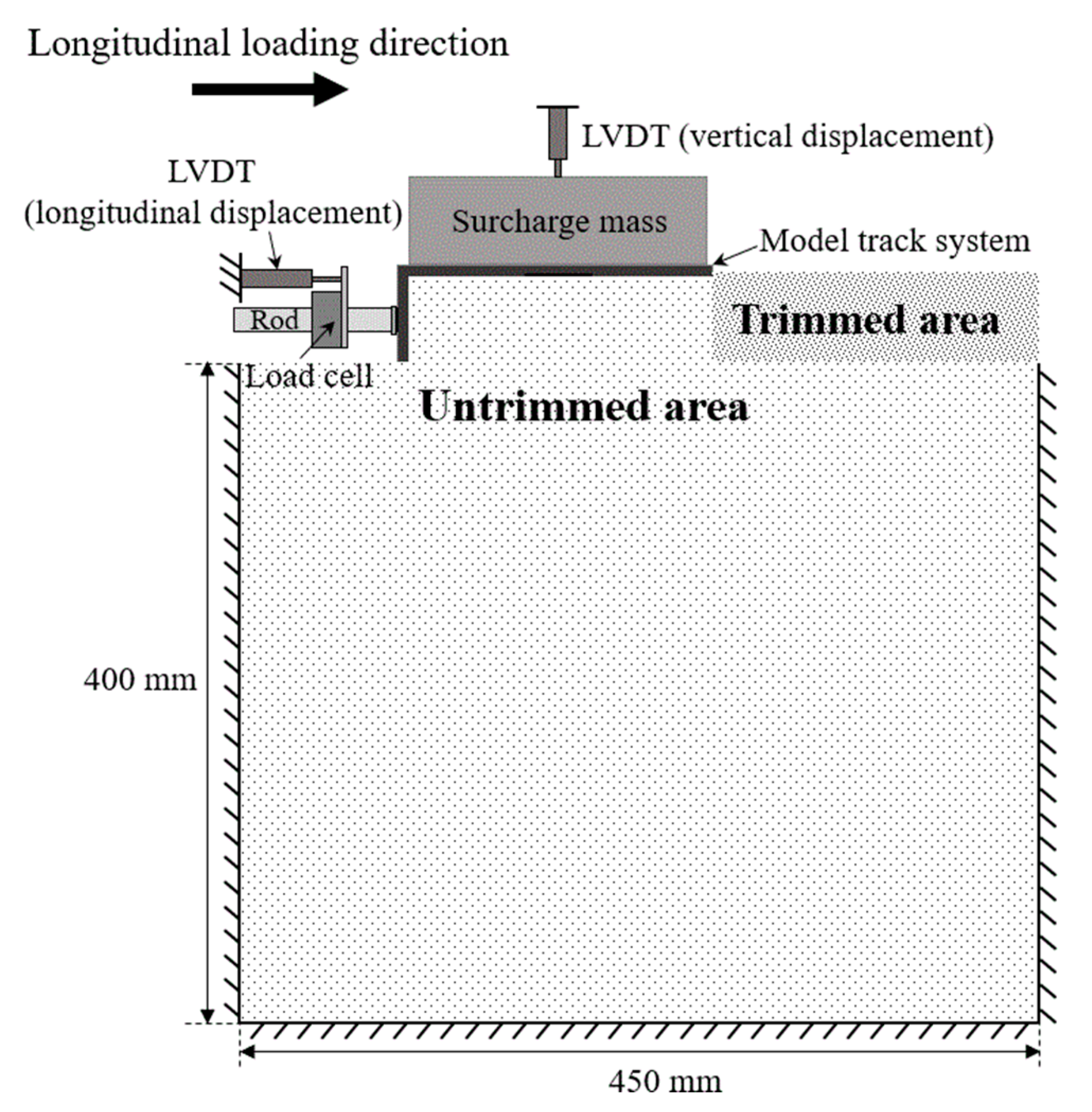

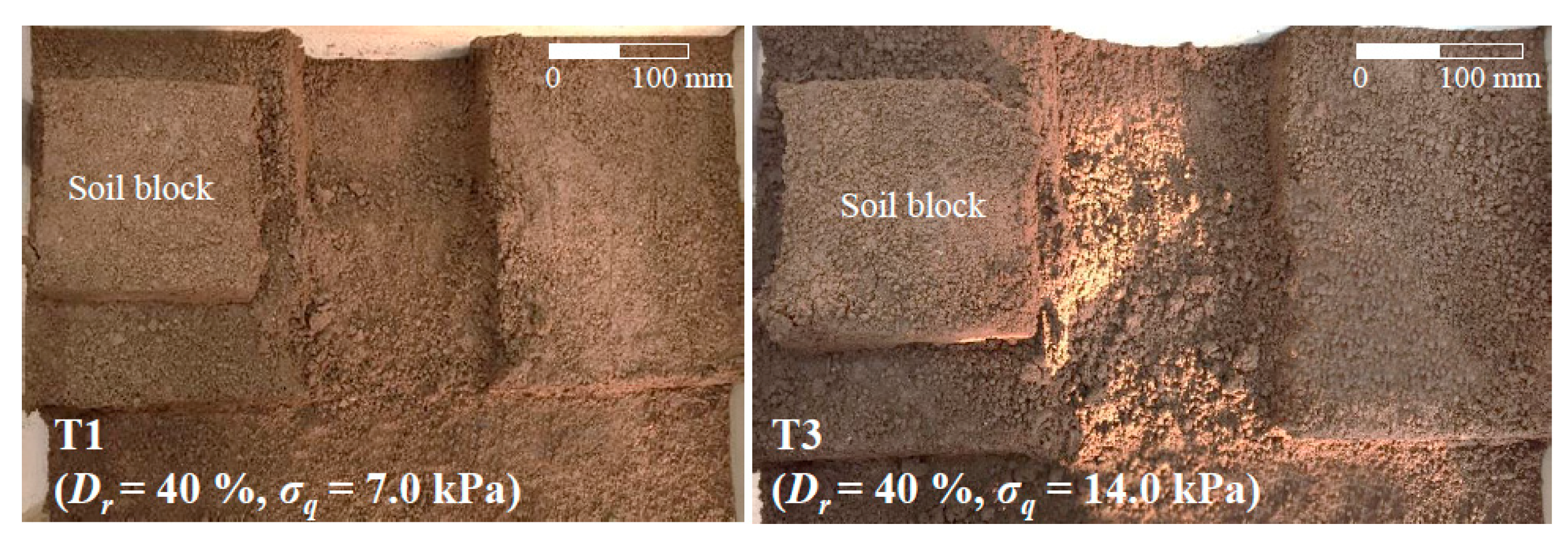
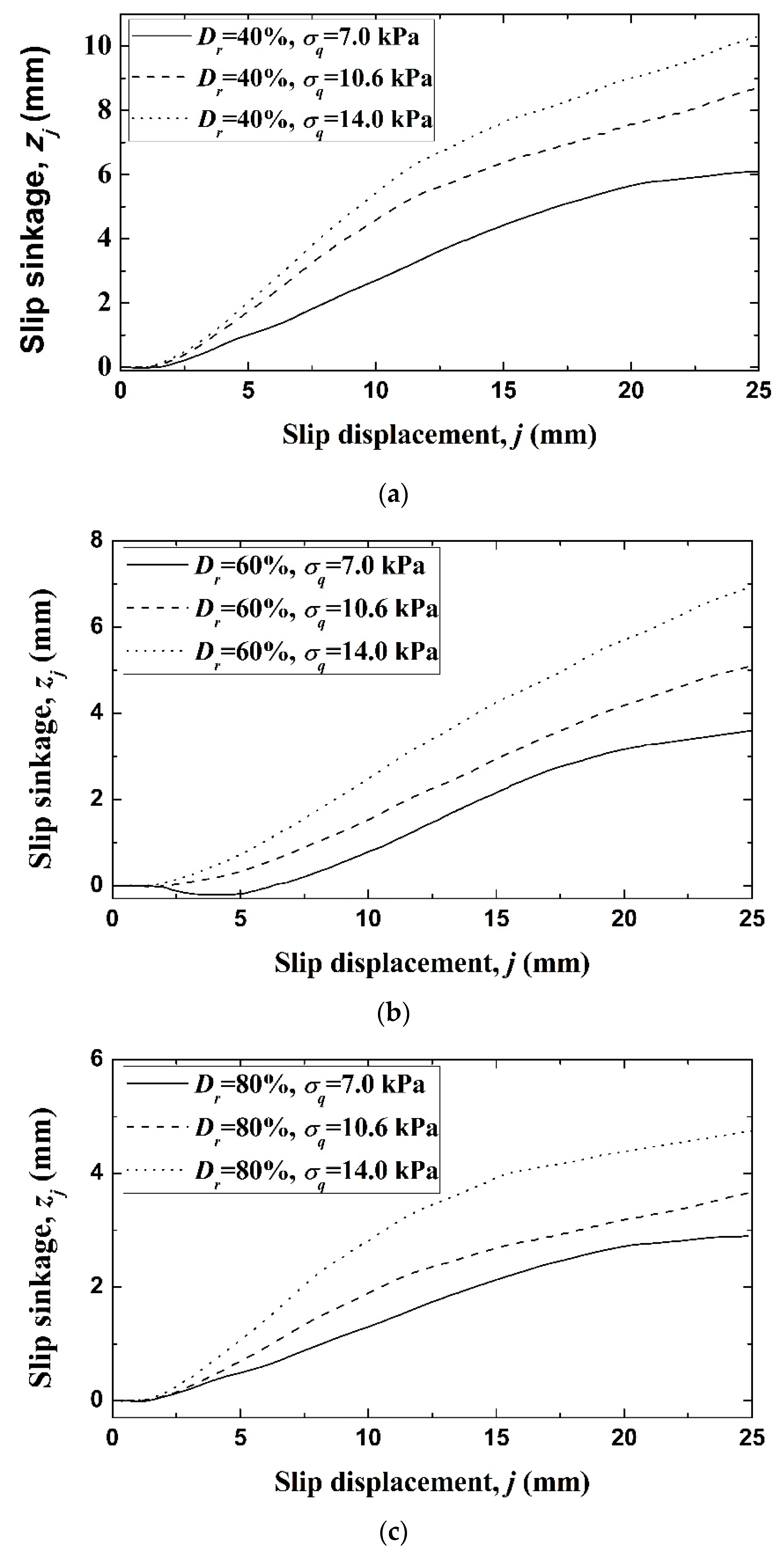

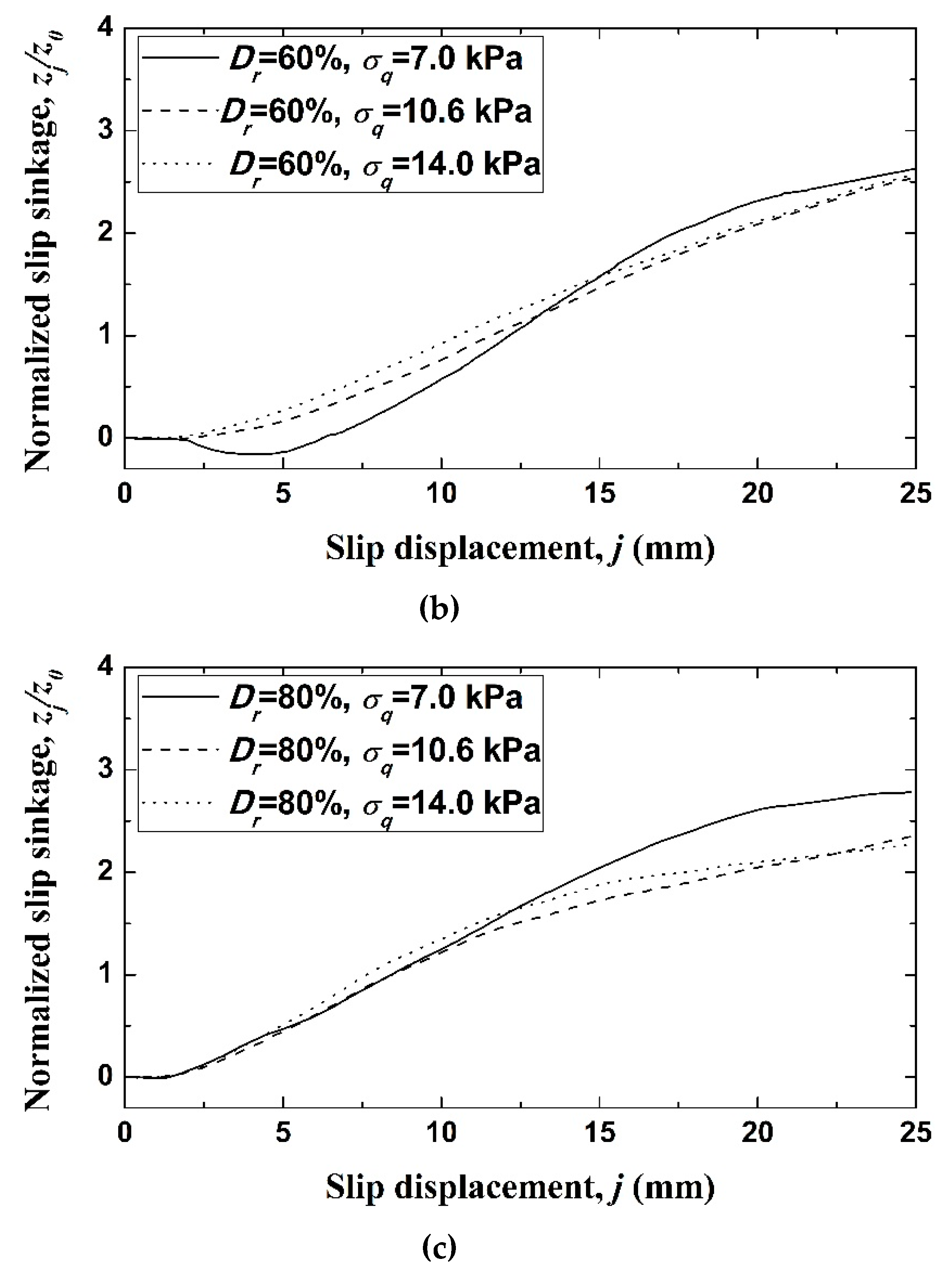
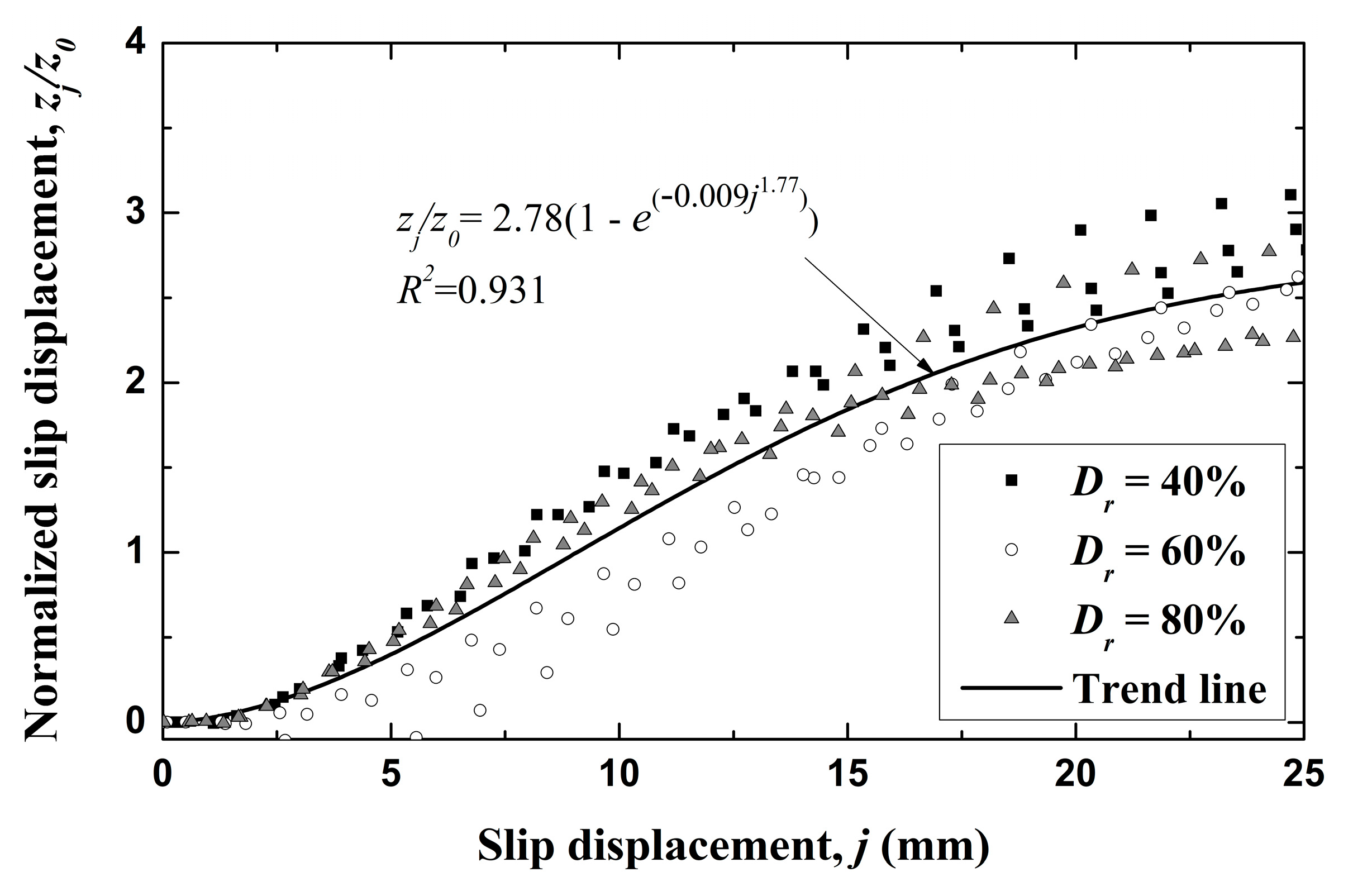
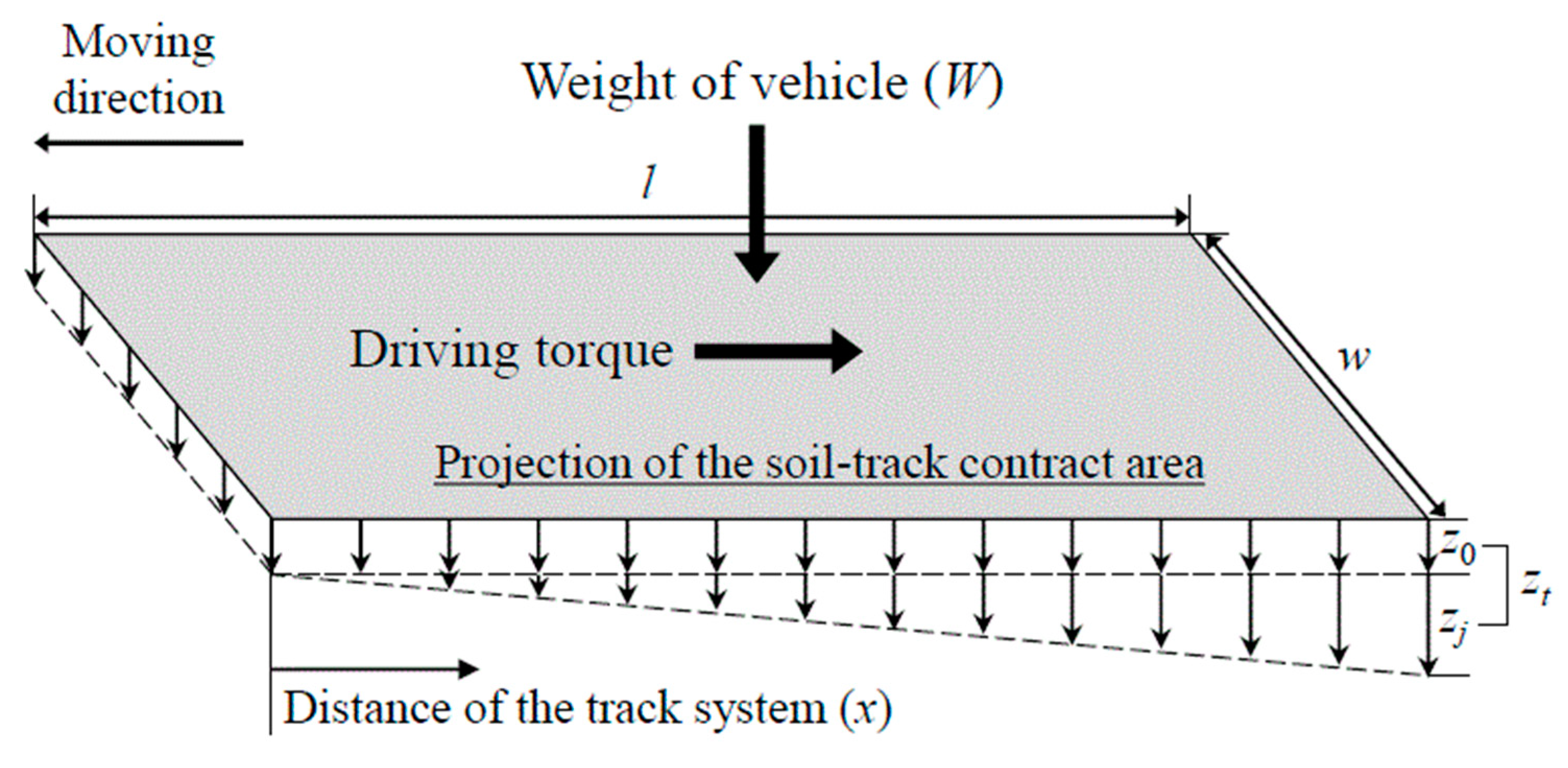
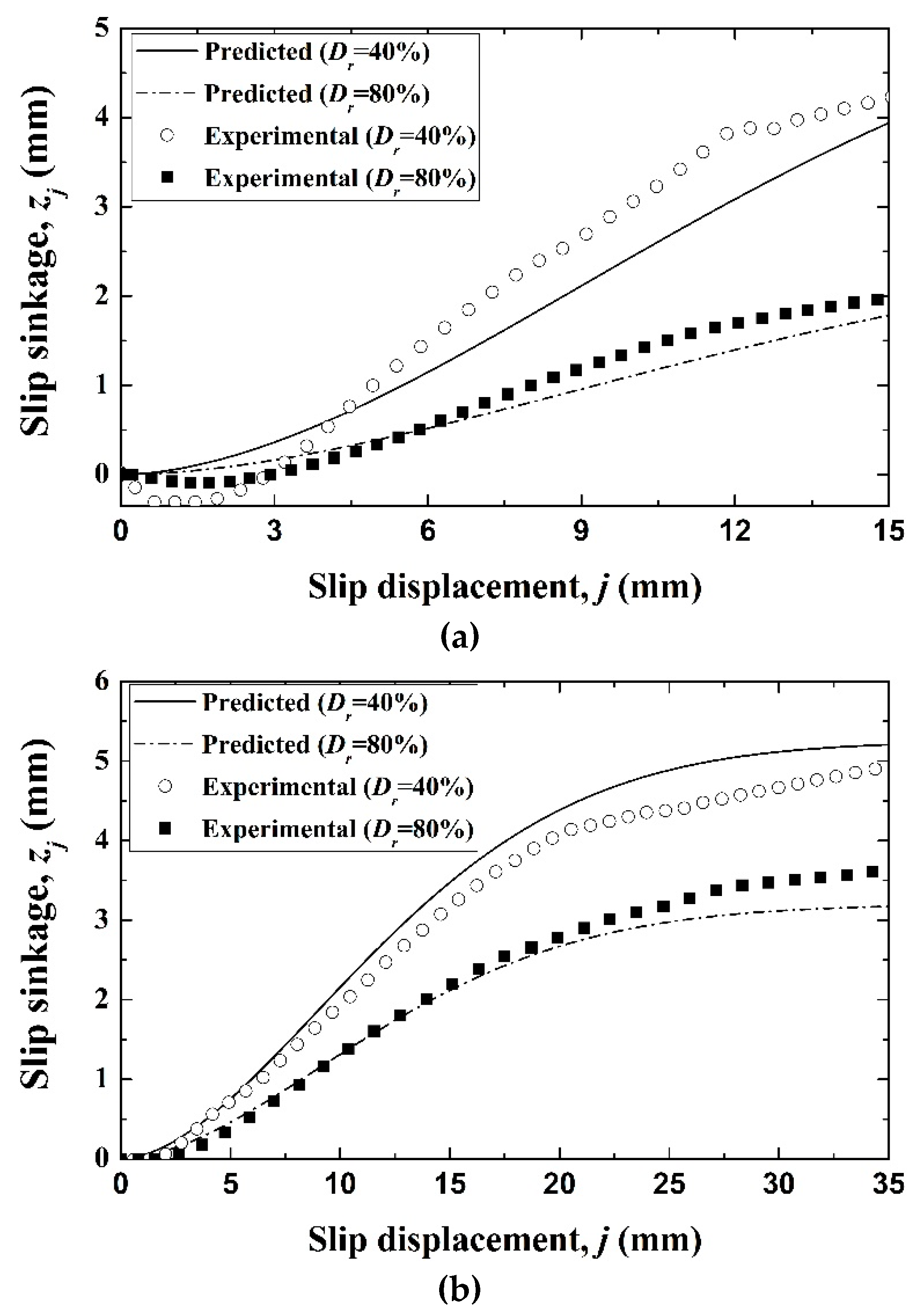
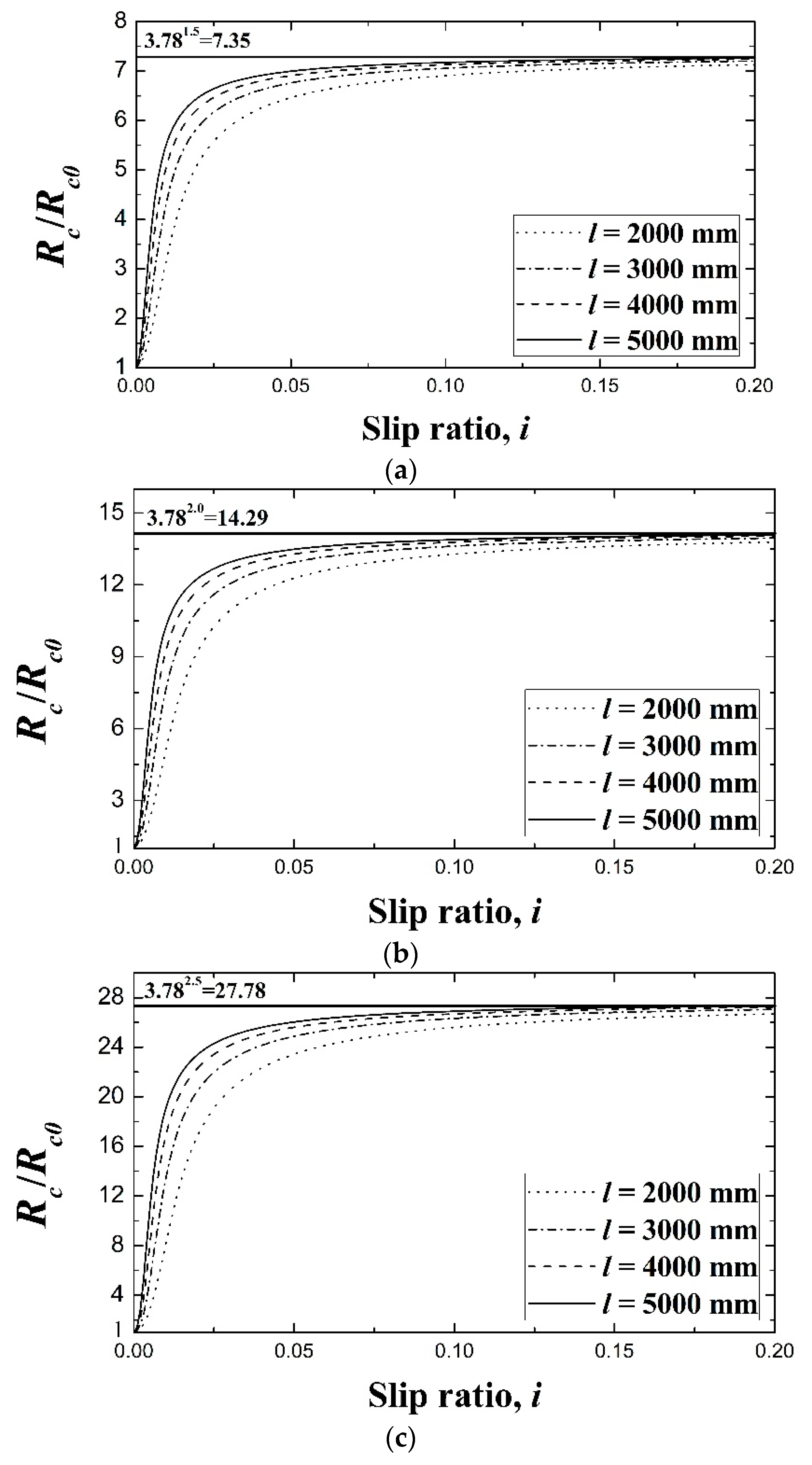

| Scale Factor (Prototype/Model) | Full-Scale Prototype | Model (λ = 1.6) | |
|---|---|---|---|
| Shape Ratio, lt/h | 1 | 3.47 | 3.47 |
| Width, w (mm) | λ | 247.7 (900) | 154.8 |
| Length, lt (mm) | λ | 247.7 | 154.8 |
| Height, h (mm) | λ | 71.4 | 44.6 |
| Thickness, t (mm) | λ | 14.4 | 9.0 |
| Vertical Stress, σq (kPa) | λ | 11.2 (68.8 kg) | 7.0 (16.8 kg) |
| 17.0 (104.0 kg) | 10.6 (25.4 kg) | ||
| 22.4 (137.6 kg) | 14.0 (33.6 kg) |
| Unified Soil Classification System Classification | SM | Maximum Void Ratio | 1.1 |
| Coefficient of Uniformity | 29.4 | Minimum Void Ratio | 0.4 |
| Mean Grain Size (mm) | 0.3 | Specific Gravity | 2.6 |
| Percent Finer than #200 Sieve (%) | 31.9 | Optimum Moisture Content (%) | 12.7 |
| Vertical Stress, σq (kPa) | Static Sinkage, z0 (mm) | ||
|---|---|---|---|
| Dr = 40% | Dr = 60% | Dr = 80% | |
| 7.0 | 1.96 | 1.37 | 1.04 |
| 10.6 | 2.99 | 2.00 | 1.56 |
| 14.0 | 3.75 | 2.69 | 2.09 |
| Model (a) | Model (b) | |
|---|---|---|
| Shape Ratio, lt/h | 2 | 5 |
| Width, w (mm) | 154.8 | 154.8 |
| Length, lt (mm) | 89.2 | 223.0 |
| Height, h (mm) | 44.6 | 44.6 |
| Thickness, t (mm) | 9.0 | 9.0 |
| Vertical Stress, σq (kPa) | 7.0 (9.7 kg) | 7.0 (24.2 kg) |
| Parameter | Range |
|---|---|
| n | 0.5, 1.0, 1.5, 2.0 |
| l (mm) | 2000, 3000, 4000, 5000 |
| i | 0–0.2 |
© 2020 by the authors. Licensee MDPI, Basel, Switzerland. This article is an open access article distributed under the terms and conditions of the Creative Commons Attribution (CC BY) license (http://creativecommons.org/licenses/by/4.0/).
Share and Cite
Baek, S.-H.; Shin, G.-B.; Lee, S.-H.; Yoo, M.; Chung, C.-K. Evaluation of the Slip Sinkage and its Effect on the Compaction Resistance of an Off-Road Tracked Vehicle. Appl. Sci. 2020, 10, 3175. https://doi.org/10.3390/app10093175
Baek S-H, Shin G-B, Lee S-H, Yoo M, Chung C-K. Evaluation of the Slip Sinkage and its Effect on the Compaction Resistance of an Off-Road Tracked Vehicle. Applied Sciences. 2020; 10(9):3175. https://doi.org/10.3390/app10093175
Chicago/Turabian StyleBaek, Sung-Ha, Gyu-Beom Shin, Seung-Hwan Lee, Mintaek Yoo, and Choong-Ki Chung. 2020. "Evaluation of the Slip Sinkage and its Effect on the Compaction Resistance of an Off-Road Tracked Vehicle" Applied Sciences 10, no. 9: 3175. https://doi.org/10.3390/app10093175
APA StyleBaek, S.-H., Shin, G.-B., Lee, S.-H., Yoo, M., & Chung, C.-K. (2020). Evaluation of the Slip Sinkage and its Effect on the Compaction Resistance of an Off-Road Tracked Vehicle. Applied Sciences, 10(9), 3175. https://doi.org/10.3390/app10093175





